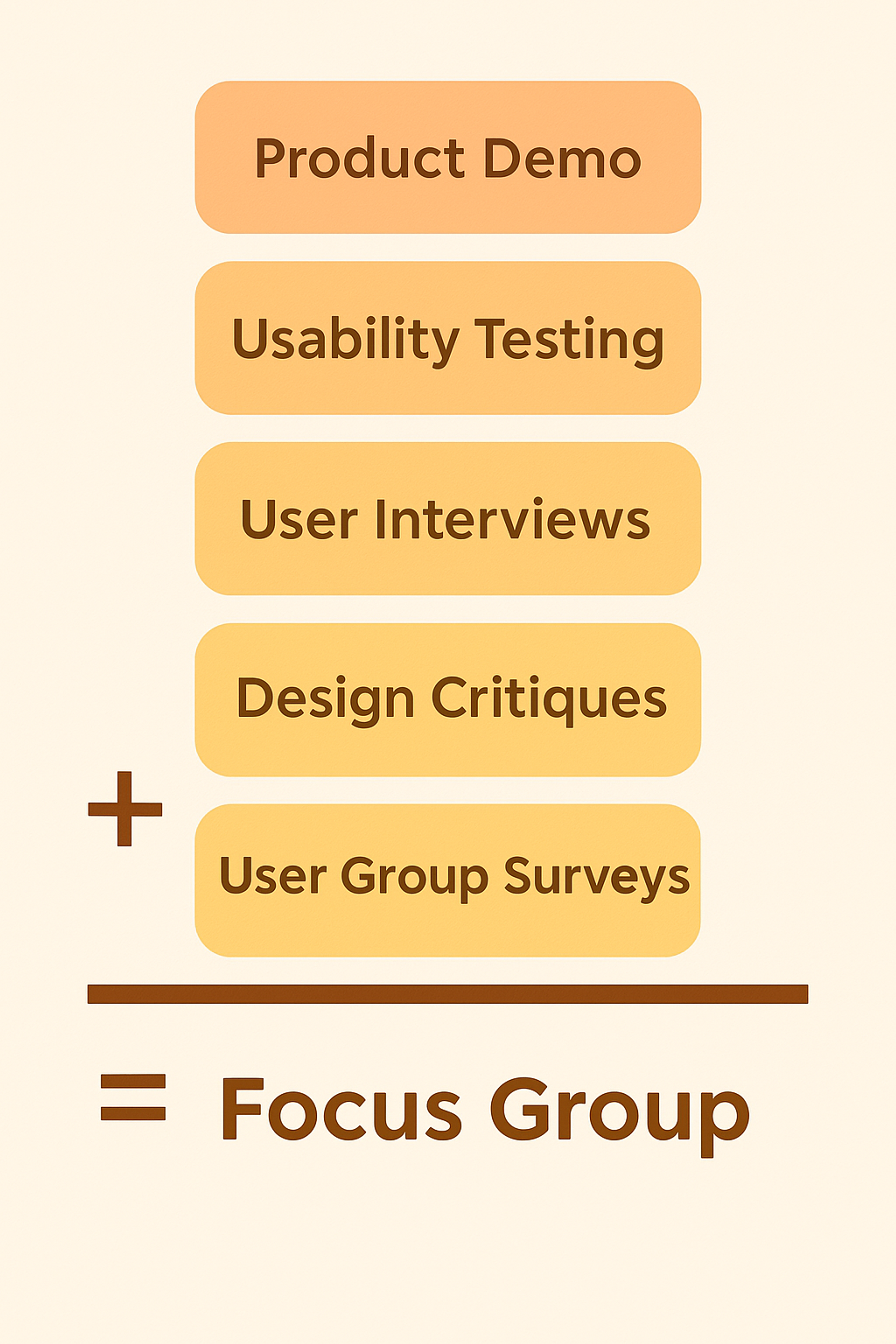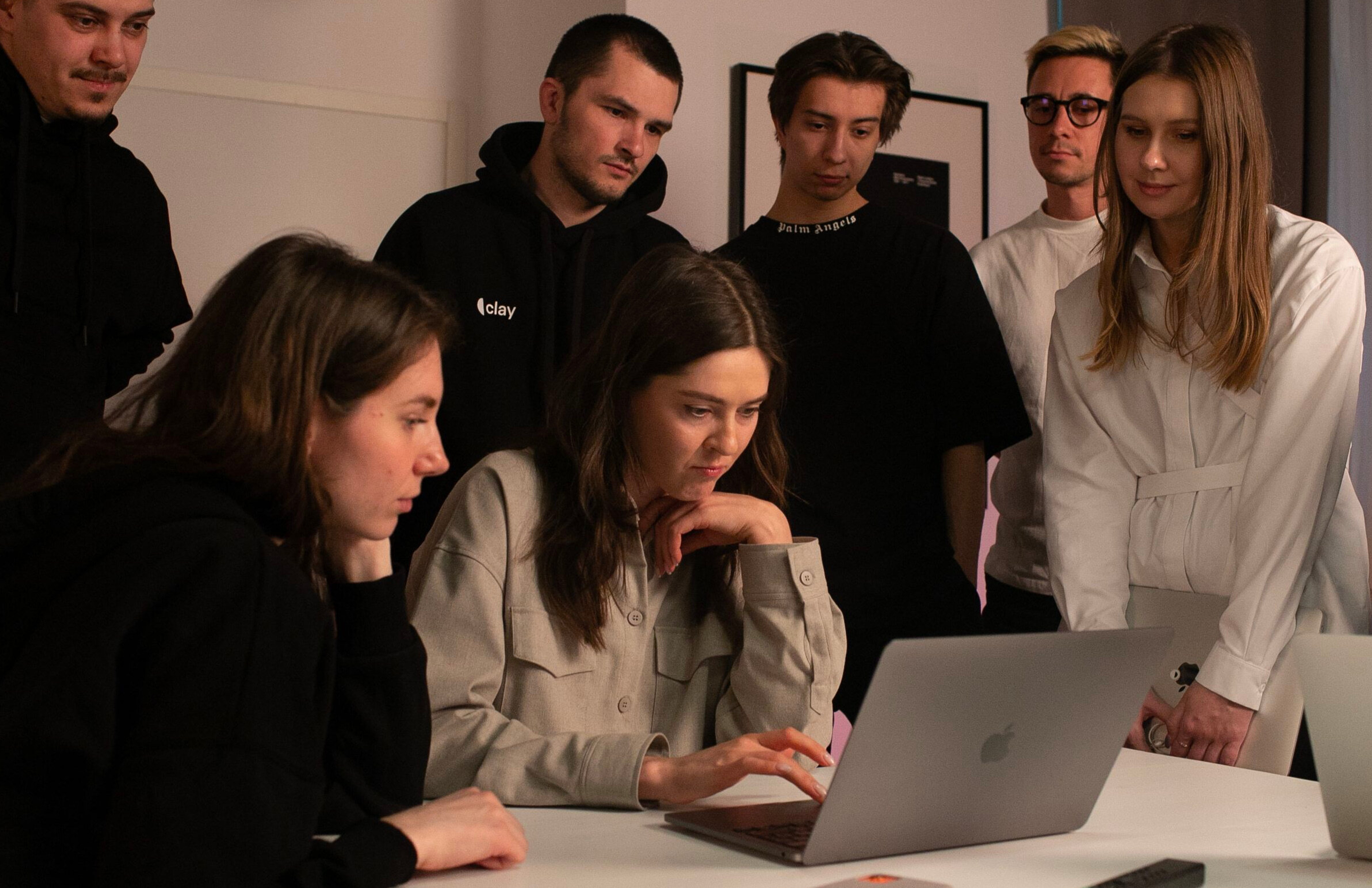Focus groups can help UX designers learn how people really use a product. By talking with a group of users, asking questions, and listening to feedback, designers analyze user feedback to get useful ideas to improve a design.
But traditional focus groups take a lot of time and money. A newer method — collaborative findings — offers a smart alternative. In this setup, smaller groups of users work together on tasks instead of answering questions alone.
This approach encourages more creativity, deeper insights, and stronger teamwork. It gives designers a clearer view of how people think and behave while using a product. In this article, you'll learn how to use collaborative findings to improve your UX design process.
Key Takeaways
Focus groups and collaborative research methods can yield unique insights about the behavior and experience of users. Here's what to keep in mind:
1.
Focus groups foster user insights by providing unmoderated discussions and real-time feedback.2.
Collaborative findings enable users to accomplish shared goals, which fosters enhanced creativity and valuable insights.3.
Target audience users provide more valuable praise and feedback, particularly when your audience participants wear the 'target audience' hat.4.
Virtual focus groups need more attention, including which focus groups to deploy and what goals to achieve.5.
Qualitative data examination includes coding and pattern recognition to ascertain user feedback.
When used with care, the focus of these methods is to improve understanding of the user's thought processes, behavioral response, and emotional reaction to the designed products.
Understanding UX Focus Group
Conducting UX focus groups refers to a research technique where a small number of individuals (usually 6-12 participants) are brought together to discuss and provide feedback on issues related to the study.
Unlike other methods like surveys or interviews, which only involve one person at a time, focus groups allow for more interactive dialogues amongst people with diverse beliefs, thereby enhancing deeper exploration of attitudes towards things under consideration.
In such a setting, the moderator guides conversation by posing questions or directing talk around particular topics, thus enabling greater comprehension of people’s thoughts and feelings concerning specific matters. They also bring out multiple perspectives, thus making it possible for researchers to discover unexpected insights that might have otherwise remained concealed.
UX Research Methods

However, there are some limitations to using focus group methodology in UX research. Focus groups can be expensive and time-consuming, primarily if the researcher works with limited resources.
Additionally, the presence of a moderator can influence the conversation among the participants since they are ultimately responsible for guiding the discussion toward topics relevant to the research.
Moreover, as with any qualitative data collection technique, unconscious biases may affect participant responses, leading to flawed results if not carefully monitored by researchers.
Definition and Types of Focus Groups
A focus group is a type of qualitative research in which a small group of subjects represents a segment of a product or service's users or customers.
The dominant aim of a focus group is to acquire information about a product, feature, and user experience. Each type has its range of focus groups, which come with different research needs and a set of distinct advantages:
- In-person focus groups: These focus groups are classic, and they are set in a neutral conference or an office. They enable physical interaction, which facilitates nonverbal signals and interpersonal movements.
- Online focus groups: These rely on videoconferencing and are convenient for clients who live far apart or in regions where physical interaction is impossible.
- Mini focus groups: These groups consist of 3 to 5 people. They are primarily used in research that requires more detailed explanations and enables a closer discussion of sensitive issues.
Hybrid focus groups combine elements of both in-person and online focus groups and provide added benefits: the flexibility of online sessions and the in-person depth of interaction offered in in-person sessions.
Researchers can appreciate understanding the various focus groups, enabling them to pinpoint the focus group that best suits the research objectives and limitations.
Source: Campaign Creators on Unsplash

Pros and Cons of Focus Groups in UX Research
Focus groups are a useful UX research tool, offering insights into user perceptions and behaviors. However, they have both advantages and drawbacks.
Pros
- Rich Insights: Discussions encourage deeper user feedback and idea-sharing.
- Exploring Complex Topics: Group dynamics uncover nuances and diverse perspectives.
- Cost-Effective: Gather multiple insights in one session, saving time and resources.
- Flexible: This can be conducted online or in person.
- Immediate Feedback: Real-time responses allow for follow-up questions.
Cons
- Limited Representation: Small groups may not reflect broader user experiences.
- Groupthink & Dominance: Some voices overshadow others, affecting objectivity.
- Artificial Setting: Responses may differ from real-world behavior.
- Analysis Challenges: Interpreting qualitative data can be complex.
- Potential Bias: Moderator influence or social desirability may skew results.
Focus Groups vs. Interviews
While both focus groups and interviews are qualified methods of UX research, each has a different role. Here is how the two compare.
Depth vs. Breadth: Interviews allow for more in-depth conversations, while focus groups allow for more opinions in a briefer time.
Group Interaction: Interviews provide more uninterrupted personal self-reflection, while focus groups allow for debate and the sharing of ideas to devise a solution.
Comfort & Bias: Groupthink and Social pressure violate the free exchange of ideas, so focus groups can be more easily controlled, while some people will be more exposed in interviews.
Time & Cost: Focus groups are more cost-efficient because participants will provide multiple opinions in a single instance, whereas interviews take longer than focus groups.
Best Use Cases: Focus groups can be used for ideation sessions, while interviews can be conducted to understand the users' journey and personal interactions with the system.
How To Conduct UX Focus Groups: Guide
Planning and Preparation
You need to balance all aspects of your focus group study evenly. You should gauge the number of people in the group, their respective roles, the questions, and the topics to be addressed.
Try to estimate the time it would take to reach your venue and the session duration too. Keep everyone in the loop so that information is disseminated to all and activities can be carried out in an orderly manner.
These include age, gender, ethnicity, and even socioeconomic status (SES), which should be considered for focus group participants.
You must also take steps to accurately target individuals who actually use the services, people who are even in the study's target group.
UX Focus Group Process

Focus group participants may be difficult to reach because people in the community are often unaware of them. Still, online forums, social media, and even community centers can be used to target more distant people, such as family, friends, and relatives.
Participants in focus groups often require some incentive in exchange for their time. This could be money or gift vouchers for related products or services.
Energizing food and refreshments can make sessions more engaging, helping participants focus. This directly improves the likelihood of participants remaining attentive for longer periods of time.
Defining Research Objectives and Scope
Having a defined objective and scope for the focus group study will make the overall outcome of the research more valuable. Objectives help determine the trajectory for the survey, giving the research scope and focus to uncover more actionable insights. While crafting the objectives, ask yourself the following questions.
- Specific: Make the objectives as straightforward as possible. Elucidate the viability of the focus group study. For instance, do you want to uncover what users wish the new feature to do, or do you want to pinpoint user pain in the experience?
- Measurable: Define what you expect to achieve and the results. What outcomes are you expecting from the focus group? Set proper indicators to measure success.
- Achievable: Make sure the objectives are practical and can be accomplished. What time, resources, and participants are necessary to reach your goals?
- Relevant: Make sure focus group study steers toward objectives that are critical to your UX design process, and that your objectives are in sync with the goals and questions of the research.
- Time-bound: Set a schedule that delineates the research period, the focus group sessions, and the deadlines for planning, conducting, and analyzing focus group data.
Research objectives and focus shape the structure and insights that a focus group study brings.
Identifying the Target Audience and Recruiting Participants
Success in focus group research hinges on the right participants. They are the ones that make research worthwhile and insightful. These are the steps to make sure that participants are the right ones:
- Talk to the target participants: When defining the ideal participants, include all relevant demographics and psychographics, such as user experience level, age, gender, and occupation.
- Draft screener questions: In focus groups, screener questions are structured to help in the sorting process and are geared toward excluding participants who do not fit the set criteria.
- Recruit participants: Consider acquiring participants using social media, digital advertising, and participant databases. Existing users or customers can also be contacted, so long as they match the target audience.
By using the right participants, researchers can guarantee that their focus group study will deliver practical and valuable information.
Focus Group Size
Pick the right size for your focus group because the wrong size can hinder focusing on specific details or aspects. A group that is too small might result in few to no people, and a group that is too large may prevent individuals from speaking if they want to.
The middle of the two scenarios and the most optimal is the 5 to 10 range. This range is the most optimal because there are enough people to generate various opinions and ideas but small enough to have a good discussion. The group members will be active participants without feeling anxious or overloaded.
If the target focus group is vast, it is better to have many small sections with smaller groups, rather than one large group. This results in better engagement and conversation while guaranteeing that every person gets a chance to contribute.
Determining the Right Moderator and Co-Moderator
Determining the right moderator and co-moderator is essential for a successful focus group study. The moderator plays a crucial role in guiding the discussion and ensuring that valuable insights are gathered. Here are some tips for selecting the right moderator and co-moderator:
- Choose an experienced moderator: The moderator must be chosen based on the research and the discussion. This person needs to be focused and in control.
- Consider a co-moderator: You can include a co-moderator to assist with note-taking, recording, and facilitating discussions. Co-moderators can provide support for the session and ensure that no salient points go unregistered and that the session receives adequate attention.
- Ensure moderator skills: Moderators should demonstrate the capability to grasp group behavior, research goals, and rapport with the participants. They also need to create a suitable and conducive atmosphere for participation, support active involvement, and resolve some problems that may result.
The right choice of moderators and a co-moderator will make it easier for researchers to conduct their focus group studies effectively and, in turn, focus on the insights that result from them.
The addition of the new section will not compromise the article's value, and it will let the piece serve as a practical and dynamic article on conducting UX focus groups that turn user feedback into designs.
Source: Austin Distel on Unsplash

Moderation Techniques and Group Dynamics
Creating an environment where participants have the freedom to openly express their opinions is an essential step to the success of the focus group research method. Every participant's voice should be captured, and a skilled moderator is crucial for the success of the focus group.
Moderators can use mirroring, reframing, summarization, and other open-ended questions to engage in meaningful discourse. These techniques also ensure that conversations do not lack substance, focus, or value and that dominant personalities do not take over.
Key Moderation Techniques
- Mirroring, in moderation, is repeating specific key phrases or words a participant has used. This technique reassures them that their input is valuable and encourages them to elaborate on their response.
- Rephrasing questions helps to obtain deeper responses. By changing broad statements to more specific questions, moderators can encourage participants to think analytically and offer comprehensive explanations.
- Summarizing discussions allows the moderator to capture the essence of the key points and stay on topic, which is useful, especially when discussions go off the rails.
A moderator is responsible for ensuring discussion and report balance. With discussion, the conversation must flow naturally, ensuring that all items on the agenda and any extra relevant topics are covered in the time available. Moderation is needed, and the flow of responses should not be pulled in any one direction to bias the discussion.
Virtual Focus Group Best Practices
With more research shifting online, virtual focus groups require special considerations to keep participants engaged and ensure valuable insights. Here are some best practices:
- Use the Right Platform: Choose a reliable video conferencing tool with screen-sharing and recording capabilities (Zoom, Google Meet, or Microsoft Teams work well).
- Set Clear Expectations: Before the session, send participants an agenda and guidelines on how the discussion will flow.
- Encourage Active Participation: Ask direct questions to quieter members and use interactive tools like polls or chat features.
- Limit Group Size: Keep it to 5-8 participants to allow for meaningful discussion without overwhelming the conversation.
- Test Technology in Advance: Ensure all participants can access the platform, check for audio/video issues, and provide troubleshooting tips beforehand.
- Create a Comfortable Atmosphere: Start with an icebreaker to ease participants into the discussion and encourage open, honest feedback.
- Record and Take Notes: With participant permission, record sessions for later review and ensure no insights are lost.
Data Collection and Analysis
In the case of your first physical focus group, there are various ways of collecting data. Having focus groups in market research, more often than not, utilize similar methods for collecting data to obtain impressions of a product and its potential value to a customer segment.
One can audio or video record the conversation to focus on what people are saying. Alternatively, focus group participants may be asked to note down points to ensure that they all remember everything that was tabled for discussion.
Focus Group Components

One of the most popular methods is thematic analysis. It examines conversations to find emerging patterns that may help us understand the user and provide value.
This is done by splitting the text into smaller units and isolating some keywords, the key ideas that those words represent, and the associated emotions. This method helps researchers identify some topics that are frequently discussed and understand the participants' values, beliefs, and behavior.
Coding is one of the tools used to work with such data. It involves segmenting the transcripts into such categories as features of a product design or positive/negative sentiments of the discussants on a given topic.
The method also helps to identify and understand the connections between various topics, enabling the identification of patterns across different groups or time intervals, and generating new research questions as needed.
Despite the effectiveness of thematic analysis, coding, and focus group discussions, the methods can still be time-consuming due to their manual nature.
Extracting Valuable Insights
Focus groups allow researchers to observe how products or services are used in practice and the interactions that take place. The result is rich, qualitative data that helps understand user behavior, preferences, and needs – even those the users are unaware of. Designers are better placed to create appropriate, real-life, user-centric solutions when they pay attention to the user and their thoughts in the interaction.
Making Sense of Qualitative Data
The most important part of focus groups is decoding the information. However, the moderators should consider more than just the focus group participants' responses.
- Emotional responses: What are the participants' reactions while listening to a particular question?
- Opinions: What are the comments and the recurrent vital aspects?
- Suggestions: What are the spontaneous user-generated solutions?
Capturing discussions, separating them into smaller blocks, and identifying repetitive patterns helps us understand what makes people feel or do what they do. Such knowledge helps us reason more thoughtfully.
Using Technology to Dig Deeper
Analyzing qualitative data is made easier with the use of NLP techniques. NLP tools are capable of:
- Extracting dominant themes from a discourse.
- Assessing a conversation and labeling the content as positive or negative.
- Mapping out a conversation and appreciating the relationships that exist among the concepts.
The impact of qualitative data is more significant when human reasoning is amalgamated with the broad and evolved focus of NLP.
Balancing Focus Groups with Other Research Methods
While focus groups offer valuable insights, they shouldn’t be the only research method used. To get a complete picture of user behavior, it’s essential to combine them with other approaches, such as:
- Surveys – Capture large-scale trends but lack depth.
- Interviews – Provide detailed individual perspectives but miss group dynamics.
- Observational studies – Show real-world behavior that users might not be able to articulate.
Each method has its strengths, and using a mix ensures a well-rounded understanding of how users think, feel, and act.
Source: Campaign Creators on Unsplash

Addressing Ethical Considerations
When using focus groups, it is important to provide the appropriate ethical safeguards, including respect for the rights, privacy, and welfare of the research subjects.
Regardless of how the session is held, ethical principles regarding the treatment of the subjects and participants should not compromise the most appropriate environment for them to share their views and opinions with ease and comfort.
Ensuring Informed Consent and Confidentiality
Before participating in a focus group, every individual must provide informed consent—meaning they fully understand the purpose of the research, what they’re agreeing to, and their rights as participants. Researchers should clearly explain:
- The topic of discussion and what will be expected of participants.
- How their responses will be recorded, stored, and used.
- Their right to withdraw at any time without consequences.
Confidentiality is another crucial aspect of ethical research. To protect participants' identities, personal data should be de-identified or replaced with pseudonyms. This ensures that no one can be personally linked to specific statements or opinions shared during the session.
Creating a Judgment-Free Environment
Participants should feel safe to share their thoughts without fear of criticism or judgment. A focus group research method should be a fear-free zone where all perspectives are respected. Researchers can encourage open discussions by:
- Setting ground rules that promote respectful conversations.
- Avoiding leading or biased questions that may influence responses.
- Providing enough background information on the topic so participants feel comfortable engaging in the discussion.
Source: Annie Spratt on Unsplash

Handling Sensitive Topics with Care
Some focus groups may explore delicate or emotionally charged topics requiring extra sensitivity. When discussing subjects that could evoke distress or traumatic memories, researchers should:
- Use neutral, non-provocative language to avoid triggering negative emotions.
- Offer access to emotional support resources, such as mental health professionals, for participants who may need assistance.
- Observe signs of distress and provide options for individuals to step away or take a break if needed.
If a participant appears uncomfortable or upset during the discussion, moderators should be prepared to offer supportive reassurance, allowing them the time and space they need to express themselves without pressure.
Protecting Privacy and Data Security
Respecting participants' privacy is fundamental. Researchers must ensure that:
- No identifying information is revealed in reports, presentations, or publications.
- Data is stored securely and only used for the intended research purposes.
- Participants’ responses remain anonymous, especially when discussing sensitive topics.
While focus groups are a valuable tool for gathering user insights, researchers have an ethical responsibility to protect participants from harm. Researchers can foster an environment where participants feel respected and secure by ensuring informed consent, maintaining confidentiality, creating a safe discussion space, and handling sensitive topics with care.
Balancing ethical considerations with meaningful research ensures that valuable insights can be collected while upholding the dignity and well-being of those involved.
Focus Group Question Examples
Asking the right questions is key to getting valuable insights. Here are some engaging and conversational focus group questions:
- General Experience: “Can you share a time when you had a great (or frustrating) experience with this product? What stood out?”
- Usability & Design: “If you could change one thing about this product’s design, what would it be and why?”
- Feature Feedback: “What’s one feature you absolutely love? Is there anything missing that you wish was included?”
- Emotional Connection: “How does using this product make you feel? Would you recommend it to a friend?”
- Competitor Comparison: “Have you used similar products before? How does this one compare?”
- Future Improvements: “If we gave you a magic wand to improve this product, what’s the first thing you’d change?”
FAQ
Q: What Makes Focus Groups Different From Other UX Research Methods?
Focus groups bring users together to discuss products, enabling group interaction that uncovers shared experiences, opinions, and unexpected insights not easily found in one-on-one research.
Q: When Is It Better To Use Collaborative Sessions Instead Of Traditional Focus Groups?
Collaborative sessions are ideal when you want users to complete tasks together. They often yield deeper insights, foster creativity, and reveal natural user behaviors.
Q: How Do Moderators Influence The Quality Of Focus Group Insights?
Moderators guide discussions, manage group dynamics, and ensure all voices are heard. Their skill can reduce bias and keep sessions focused and productive.
Q: What Are Some Best Practices For Running Online Focus Groups?
Use a reliable video platform, share clear guidelines in advance, limit group size, test technology beforehand, and actively engage participants to get the best results.
Q: Why Is Participant Selection So Important In UX Focus Groups?
Choosing the right participants ensures feedback comes from real users who match your audience, making the insights more relevant and actionable.
Read More
Conclusion
In general terms, these gatherings provide useful insights into how users interact with products or services. Therefore, qualitative research methods such as interviews based on groups are employed to collect data from individuals who participate voluntarily. Hence, researchers need to be sensitive toward protecting their rights and well-being while dealing with these types of inquiries.
In addition, confidentiality can only be achieved through informed consent procedures. Therefore, when handling topics that may expose personal information in public contexts like market surveys, it becomes necessary to ensure privacy through agreement signing before the discussion starts within a safety zone that guards against identification risk linked with specific locations or organizations involved.
By using both quantitative and qualitative methods together in triangulation, design decisions related to the user experience can be more informative. This is because a broader understanding of user preferences can inform UX design choices.


About Clay
Clay is a UI/UX design & branding agency in San Francisco. We team up with startups and leading brands to create transformative digital experience. Clients: Facebook, Slack, Google, Amazon, Credit Karma, Zenefits, etc.
Learn more

About Clay
Clay is a UI/UX design & branding agency in San Francisco. We team up with startups and leading brands to create transformative digital experience. Clients: Facebook, Slack, Google, Amazon, Credit Karma, Zenefits, etc.
Learn more



